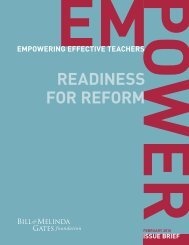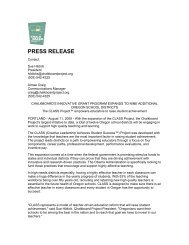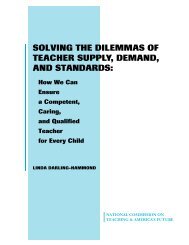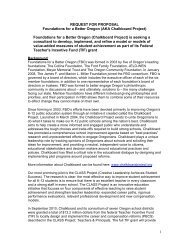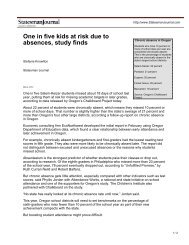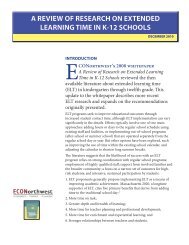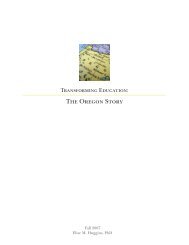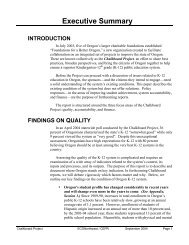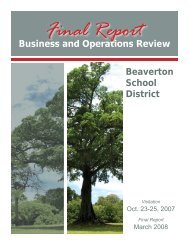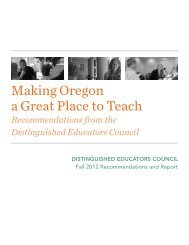Tapping the Potential - Alliance for Excellent Education
Tapping the Potential - Alliance for Excellent Education
Tapping the Potential - Alliance for Excellent Education
Create successful ePaper yourself
Turn your PDF publications into a flip-book with our unique Google optimized e-Paper software.
A L L I A N C E F O R E X C E L L E N T E D U C AT I O Nyears or requiring extensive internships; o<strong>the</strong>rs established induction programs <strong>for</strong><strong>the</strong> first one to three years of teaching.Programs expanded enough that, in 1979, <strong>the</strong> <strong>Education</strong>al Testing Service (ETS)commissioned a survey of <strong>the</strong> history and evaluation of orientation programs <strong>for</strong>novice teachers. Many types were listed in <strong>the</strong> ETS report, along with reasons <strong>for</strong> <strong>the</strong>irestablishment. Most programs were small, incomplete, and locally designed and funded.The report describes, <strong>for</strong> example, a New Hampshire program that was uniquebecause it did not collaborate with an institution of higher learning yet provided ateacher’s sole route to recertification, and several special-purpose induction programsin seven states, such as those designed especially <strong>for</strong> rural teachers. 8In <strong>the</strong> 1980s many state legislatures, including Connecticut and Cali<strong>for</strong>nia, beganto mandate induction programs. A few states went so far as to specify program contentand design <strong>the</strong> delivery system. As <strong>the</strong> research on induction was still relativelyweak, however, most of <strong>the</strong>se programs were nei<strong>the</strong>r comprehensive nor based onsolid research.Meanwhile, <strong>the</strong> 1983 publication of A Nation at Risk drew widespread national attentionto <strong>the</strong> state of American schools. The electrifying rhetoric of this report resultedin <strong>the</strong> emergence of a powerful consensus to re<strong>for</strong>m American education. Politicians,business leaders, educators, and ordinary citizens all joined toge<strong>the</strong>r to push <strong>for</strong> aquality education <strong>for</strong> all students. Among o<strong>the</strong>r things, A Nation at Risk claimed thatAmerican teachers were ill-prepared. Teachers were roundly criticized <strong>for</strong> <strong>the</strong>ir inabilityto teach higher-level thinking, particularly in <strong>the</strong> subjects of math and science.The publication of A Nation at Risk gave rise to a series of “educational excellence”re<strong>for</strong>ms designed to change <strong>the</strong> nature of schools, students, and teachers. Teacherretention quickly became a source of major concern. At first, researchers examined ahost of factors influencing <strong>the</strong> retention of new teachers. Largely ignoring induction,or variations in teacher quality, researchers focused on teacher salaries and schoolquality to help explain and correct <strong>for</strong> teacher attrition. 9A Nation at Risk was followed by A Nation Prepared, a 1986 report that called <strong>for</strong> anational board to “establish high standards <strong>for</strong> what teachers need to know and beable to do, and to certify teachers who meet that standard.” 10 Of course, this recommendationwas realized in <strong>the</strong> establishment of <strong>the</strong> National Board <strong>for</strong> ProfessionalTeaching Standards. Anticipating many of <strong>the</strong> features of what are now understood aspositive features of induction, <strong>the</strong> report recommended creating decisionmaking structuresin which “lead teachers” would play important roles and teachers would direct<strong>the</strong>ir own support staffs.By <strong>the</strong> mid-1980s, some school administrators and teacher educators concluded thatinexperience accounted <strong>for</strong> many of <strong>the</strong> problems facing new teachers. The onlypreparation that most beginning teachers had was <strong>the</strong> semester-long student-teacherexperience. This was not sufficient. Student teachers had not survived a series ofinstructional failures, experienced students’ boredom, discovered a wall of studentlearning resistance, or felt <strong>the</strong> isolation of “teaching <strong>for</strong>ever.” Student teachers did notcharacteristically experience <strong>the</strong> demands of meetings, red tape, extracurricular activities,and student/parent conferences. 11iv



